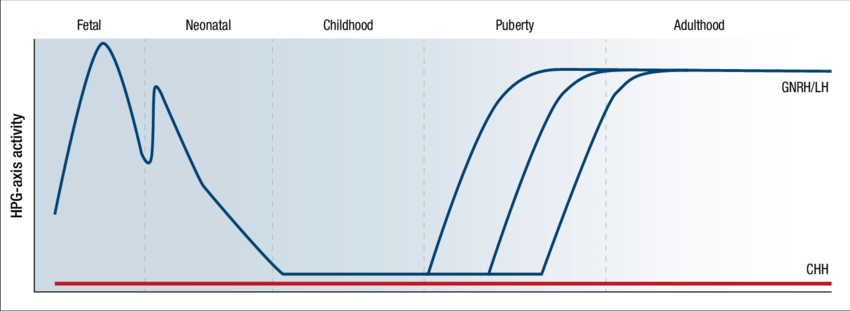Triggers of Puberty
What Triggers the Onset of Puberty?
 File photo | Credit: FatherlyOpens in new window
File photo | Credit: FatherlyOpens in new window
In contrast to common misconceptions that puberty is one single event, it is actually a long process that involves a series of related, but distinct, neural and hormonal changes. Some of these changes, such as the first menstrual period or the deepening of a boy’s voice, are obvious, but others, such as increases in height or appearance of body hair, occur so gradually that only after they are well underway do they become noticeable. |
While it is the case that the HPG axis is most active during pubertal onset, it wears many hats and is actually also active much earlier in life, long before adolescence. In fact, it plays an organizational role in organizing the brain prenatally, in the developing fetus. In the organization phase, the HPG helps create sexual differentiation of certain brain structures.
Sex hormones guide male and female brains along slightly different paths. Three areas of the brain in particular — the hypothalamus, amygdale, and hippocampus — exhibit sex differences in structure and size. These differences are not very obvious until adolescence and in adulthood but the divergent paths begin to occur prenatally. These regions are involved in reproduction, both in terms of hormone release (hypothalamus) and in orientation toward social stimuli in adolescence and adulthood (amygdale).
 Figure X-1 Gonadotropin-releasing hormone (GnRH) fluctuates throughout development. It is released prenatally, is relatively inactive in childhood, and then surges at puberty before decreasing throughout adolescence and adulthood.
Figure X-1 Gonadotropin-releasing hormone (GnRH) fluctuates throughout development. It is released prenatally, is relatively inactive in childhood, and then surges at puberty before decreasing throughout adolescence and adulthood. |
By the time adolescenceOpens in new window comes around, the HPG axis takes on an activational role, in which it activates hormonal changes in ways that subsequently influence the changes in behavior and cognition that are characteristic of adolescence. Interestingly, the HPG axis is quite dormant during childhood, a departure from the organizational and activational roles it plays in childhood and adolescence, respectively.
Looking closely at Figure X-1, you will see the pattern of hormonal fluctuations across development; a rise in hormones in prenatal development wanes during early postnatal development and childhood.
In adolescence there is a sharp increase before decreasing again in adulthood. This means that the HPG axis and its hormones take a long break when individuals are children and therefore do not exert much influence on body structure, brain development, or behavior during childhood. So what “reawakens” the HPG axis during adolescence?
Surprisingly, scientists do not have an answer to this question! Decades of research in animals and humans have not identified any one hormone, event, age, or environmental experience that triggers puberty. Instead, all of these factors come together to signal that the organism is healthy enough and physically mature enough for sexual reproduction.
These factors have been called “permissive signals” because they permit (or stop inhibiting) pubertal onset (Sisk and Foster, 2004). These signals include changing levels of melatonin, body fat, and leptin, all of which are related to weight and energy balance. It is believed that individuals do not go through puberty until they are energetically and metabolically capable of doing so.
Frisch and Revelle suggested that there may be a critical weight or amount of body fat required for the establishment of normal menstrual cycles (Frisch and Revelle, 1970). Why might that be? Consider for a moment some of the potential consequences of being sexually mature: pregnancy, caring for offspring, and defending one’s territory or mate.
All of these activities are energetically expensive so perhaps delaying puberty until the organism is energetically balanced is nature’s built-in-trick to ensure that individuals who are not yet physically ready are not placed in the position to attend to the potential outcomes associated with puberty.
Decades of research have led to the conclusion that metabolic conditions and the amount of energy reserves of the organism play an essential role in the regulation of pubertal timing (Fernandez-Fernandez et al., 2006; Martos-Moreno, Chowen, and Argente, 2010). This makes good biological sense, especially in the female.
The reproductive capacity, which refers to the potential metabolic drainage of pregnancy and breastfeeding, is only acquired when threshold energy stores and optimal metabolic conditions are achieved. The influence of metabolic signals on puberty and fertility is also found in the male, in which energy demands for proper reproduction are not so evident but are probably required as well (e.g. for territoriality and partner selection) (Elias, 2012).
 Figure X-2 A group of young adolescents. Despite being in the same grade (7th grade) and roughly the same age, there are obvious differences in pubertal maturation, with some exhibiting greater physical growth and more advanced pubertal stage than others.
Figure X-2 A group of young adolescents. Despite being in the same grade (7th grade) and roughly the same age, there are obvious differences in pubertal maturation, with some exhibiting greater physical growth and more advanced pubertal stage than others. |
Timing Is Everything
One wrinkle in determining when puberty starts is that the onset of puberty is quite varied across individuals. Even though everyone starts puberty around the time of adolescence, everyone’s timing is slightly different. This point is illustrated in Figure X-2, which shows a group of 7th graders who are all roughly the same age but who exhibit vast variation in pubertal maturation and physical development.
Because of the many factors that influence puberty in each individual, there is no one single age at which everyone undergoes puberty. It is similar to the variability in motor development milestones; most infants begin walking by 18 months but some begin much earlier than that and others at a later time. Neither is better or worse, just different.
The range of pubertal onset is similarly variable, between 9 and 16 years of age in most individuals (Nottelmann et al., 1987). The pubertal transition lasts between 1.5 and 6 years in girls and 2 to 5 years in boys.
This duration is quite a long time, especially when contrasted against the comparable intervals in other species who range from a few weeks (mice) to a few months (nonhuman primates).
The prolonged period of pubertal transition in humans can probably be attributed to the much more complex environments in which human adolescents are reared. In humans, variations in diet and physical activity, stress, ethnicity, and family all impact the timing and duration of puberty.
Genetic Factors
Genetic factors play a strong role in pubertal timing, with a heritability rate of approximately 49 – 82% (Anderson, Dallal, and Must, 2003; Morris, Jones, Schoemaker, Ashworth, and Swerdlow, 2011). A girl experiences her first period at roughly the same age as her mom and her sisters did. Identical twins, who share all the same genes, undergo puberty at roughly the same time.
However, identifying the exact genes that help regulate puberty is still a puzzle that scientists are working to solve. Research does suggest that genes coding for the protein Kisspeptin, encoded by the Kiss1 gene, are involved in the control of puberty (Tolson and Chapell, 2012) by regulating GnRH function.
Experimental evidence from animals demonstrates that during puberty the Kiss1 system in the hypothalamus undergoes an extensive and complex activational program that seems essential for proper pubertal timing (Sanchez-Garrido and Tena-Sempere, 2013). This evidence includes an increase in the expression of the Kiss1 gene during pubertal maturation (Navarro et al., 2004), a sharp rise in the number of kisspeptin neurons during early puberty (Teles, Silveira, Tusset, and Latronico, 2011). Together, the expression of the kisspeptin system seems to get the brain (and body) ready for puberty.
Psychosocial Factors
Across generations, people are undergoing puberty at younger and younger ages. Although the average of menarcheOpens in new window has not fallen much in the past 70 years, the lower age limit for pubertal onset appears to be getting earlier and earlier with each successive generation.
Since the 1990s there has been a trend toward earlier age of breast budding in the United States, and a lesser decrease in the age at menarche (Anderson et al., 2003; Morris et al., 2011). This secular trend of younger and younger age of menarche has also been observed in other countries, including China, India, England, and Japan.
Scientists have speculated that this trend is due to the significant change in our diet from a leaner diet to one that is richer in calories and fat: trends in pubertal timing are parallel by increasing rates of obesity and higher body mass index (BMI), a measure of body fat based on height and weight.
At least one study has reported that BMI is associated with age of pubertal onset, such that obese or overweight boys and girls are reaching puberty earlier (De Leonibus et al., 2014).
Another study found that diet quality was indeed associated with earlier puberty (Cheng et al., 2010). Recent analysis from a large dataset indicated that children of normal BMI values rarely showed breast or pubic hair development before 8 years (3.2% and 0.6%), but overweight and obese girls had earlier breast budding, pubic hair, and menarche, independent of race or ethnicity (Rosenfield, Lipton, and Drum, 2009).
Theories about the role of weight and pubertal timing are controversial today but were quite pioneering when they were first proposed. The discovery of leptin in 1994 (Zhang et al., 1994) offered a candidate hormone that links body fat to the endocrine changes associated with puberty.
Leptin is a hormone that helps inhibit hugner. An early longitudinal study of eight boys showed a small peak in leptin level prior to the onset of puberty (Mantzoros, Flier, and Rogol, 1997).
The small sample size made it hard for some scientists to find the results credible, but subsequent larger studies corroborate the initial study by reporting a slow and steady rise in leptin levels prior to puberty (Ahmed et al., 1999). Sex differences in leptin have also been reported: in girls, leptin continues to rise after the onset of puberty, whereas in boys, leptin declines sharply (Ahmed et al., 1999).
Another piece of evidence linking leptin to puberty is that children who lack leptin for one clinical reason or another do not begin puberty until leptin is artificially introduced into the body (Farooqi, 2002). These and other studies suggest that leptin is necessary for pubertal development and that it may play a role in the tempo of its progression, but is not sufficient to trigger puberty. It is now considered to play a more permissive, rather than active, role in pubertal timing.
See also:
- Blakemore, S.J., Burnett, S., and Dahl, R.E. (2010). The role of puberty in the developing adolescent brain. Human Brain Mapping, 31, 926 – 933.
- Sisk, C.L., and Foster, D.L. (2004). The neural basis of puberty and adolescence. Nature Neuroscience, 7,1040 – 1047.

